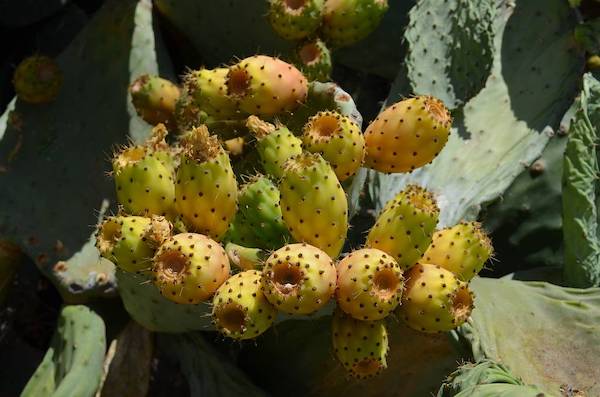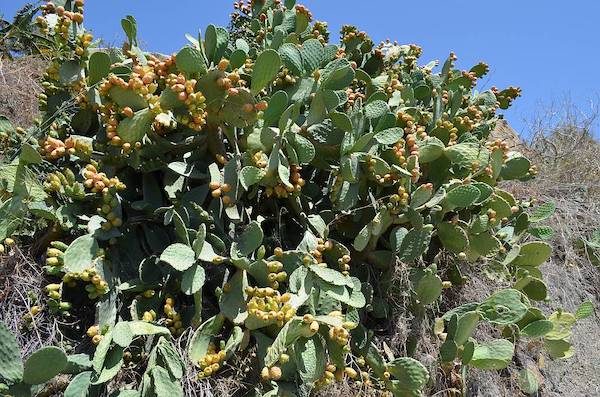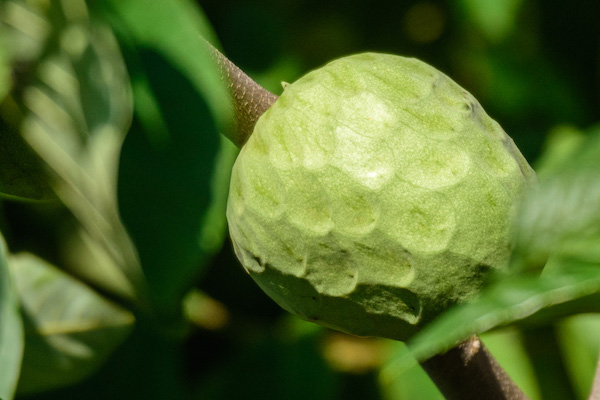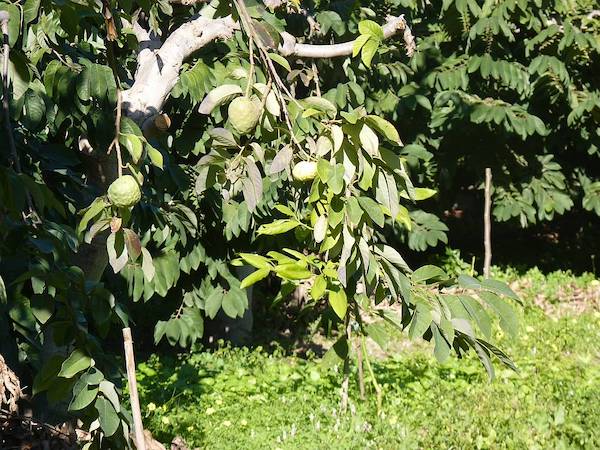The Prickly Pear, Opuntia ficus-indica, is a genus in the cactus family Cactaceae and in keeping with all true cactus species, only occurs in the western hemisphere.
They were introduced into Europe by the Spanish, possibly in 1493 after Christopher Columbus returned from the Americas, and are to be found all along the Mediterranean coast. Prickly Pears were often to be found on ships in order to help prevent scurvy, a common affliction amongst latter day sailors.
The fruit of the Prickly Pear, variously known as cactus fruit, cactus fig, Indian fig and a few more besides, is edible but takes quite a bit of careful preparation. This is because of two sets of spines, one set of large spines and one set of smaller, almost furry spines which, if not properly removed, can detach and cause irritation to the throat.
These days in southern Spain, consumption of the Prickly Pear is fairly localised and is generally eaten as a dessert.
On the other hand, Mexican natives have happily munching Prickly Pears as food for thousands of years and also make an alcoholic drink from it, known as colonche. The Maltese, amongst others, also brew an alcoholic drink from the Prickly Pear.


Most of the Prickly Pears tend to grow in cluttered ‘clumps’ and are sometimes used as a sort of natural fencing, quite effective one would imagine. There are not many humans, and even fewer animals, who would fancy getting tangled up with all those sharp spines.
Order: Caryophyllales
Family: Cactaceae
Subfamily: Opuntioideae
Tribe: Opuntieae
Genus: Opuntia
Papaya
For centuries, mango and papaya plants had an exotic, ornamental presence in the gardens of the well-to-do in the Canary Islands and Málaga, the fragrant fruits with their orange flesh providing the occasional delicious treat. In the 1980’s, however, farmers with a good eye for developing markets recognized their potential and started growing them as a commercial crop.
Papayas and mangoes arrived in coastal Spain from the tropics in the 18th century, a period when Spain’s possessions extended over four continents. The first mangoes were brought in on galleons from the Philippines, although the species originated in India, and papayas arrived on merchant ships from the Americas.
For 200 years, papayas and mangoes adorned gardens and orchards, acquiring particular characteristics from Atlantic influences in the case of the Canaries, and Mediterranean ones in the case of coastal Málaga.
In the almost tropical climate that both areas enjoy, the papaya and mango trees that once graced local gardens have successfully transmuted into cultivars grown in protected greenhouses in the Canaries and open-air plantations in Málaga.
Chirimoya
The Chirimoya, Annona cherimola, abounds in Málaga and Granada provinces, Spain being the largest producer of these fruits with around 30,000 tons per year for the domestic market. The Chirimoya, or Custard Apple, originated in the high Andes of Peru and Ecuador. It was first introduced into the Caribbean area and then taken to various tropical areas by Europeans.
The Spanish conquistadors called it ‘manjar blanco’ but the name actually derives from the Quechua word ‘Chirimuya’ or ‘cold seeds’. The plant is produced and consumed in Peru, Ecuador, Chile, Bolivia, Colombia, Spain, USA, South Africa and Israel.


The Chirimoya is 75% water with carbohydrates (glucose and fructose) and fibre. It also contains Vitamins A and C, Potassium, Magnesium, Phosphorus, Calcium, Iron, Niacin, Riboflavin, Theanine, folic acid, ascorbic acid and antioxidants. It is considered beneficial to blood sugar levels and helps with the elasticity, firmness, and suppleness of the skin.
Chirimoyas are ripe when the skin darkens to a brownish colour and the best way to eat them is to remove the seeds (there are a LOT of seeds) and scoop out the fruit with a spoon. Straight from the tree is the ultimate way to eat them, so be prepared and always carry a spoon!